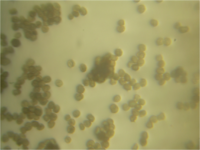
Photo from wikipedia
Corn smut fungus (Ustilago maydis [DC.] Corda) is a globally widespread pathogen affecting both forage and sweet maize hybrids, with higher significance in sweet maize. Remote sensing technologies demonstrated favorable… Click to show full abstract
Corn smut fungus (Ustilago maydis [DC.] Corda) is a globally widespread pathogen affecting both forage and sweet maize hybrids, with higher significance in sweet maize. Remote sensing technologies demonstrated favorable results for disease monitoring on the field scale. The study focused on the changes in vegetation index (VI) values influenced by the pathogen. In this study, four hybrids, two forage maize and two sweet maize hybrids were examined. Artificial infection was carried out at three different doses: a low (2500 sporidium number/mL), medium (5000 sporidium number/mL) and high dose (10,000 sporidium number/mL) with a non-infected control plot for each hybrid. The experimental plots were monitored using a multispectral UAV sensor of five monochrome channels on three different dates, i.e., 7, 14 and 21 days after infection. Five different indices (NDVI, GNDVI, ENDVI, LCI, and NDRE) were determined in Quantum GIS 3.20. The obtained results demonstrated that the infection had a significant effect on the VI values in sweet maize hybrids. A high-dose infection in the Dessert R 73 hybrid resulted in significantly lower values compared to the non-infected hybrids in three indices (NDVI, LCI and GNDVI). In the case of the NOA hybrids, GNDVI and ENDVI were able to show significant differences between the values of the infection levels.
Journal Title: Agronomy
Year Published: 2023
Link to full text (if available)
Share on Social Media: Sign Up to like & get
recommendations!